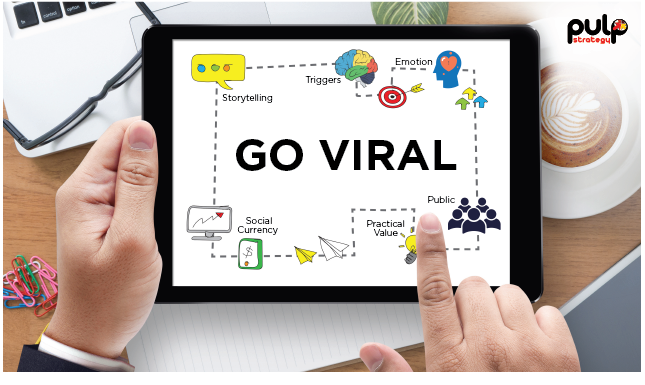At its core, viral marketing is simply the "spread of an idea" that helps market your business or cause. It's putting material out there that by its very nature attracts attention and discussion. But it’s not that simple. Today, content is everywhere. Social networks are continuously innovating for content forms that can ensure eyeballs, attention and most importantly, shares, particularly when human attention spans have gone worse than that of a goldfish.
So if ‘virality’ of your content is a parameter of quality and success for you, you need to know what exactly makes for a viral content.
What makes a piece of content viral?
According to Professor Jonah Berger of the Wharton School of the University of Pennsylvania, there are 6 principles of virality.
1- Social currency – We share what makes us look good.
2- Triggers – We share what’s at the top of our minds.
3- Emotion – We share what we care about.
4- Public – We imitate what we see people around us are doing.
5- Practical Value – We share things that have value to others.
6- Stories – We share stories, not information.
Social currency
What is social currency? According to Wikipedia, social currency is information shared which encourages further social encounters.
Social media is no longer just a source of entertainment or information or communication for us. It is so integral to our lives that we now have our own online personalities. What we like or share or write about on social media makes others form a perception about us. And that’s why, we only share what makes our online personality impressive. We don’t share things that make us look outdated, boring or uncool.
Before we share a piece of content, we (unknowingly) evaluate its social currency. The better it makes us look, the better are the chances of us passing it on. That’s the reason, stories around current trends, current state-of-affairs, topics of common interests etc. get shared promptly. People like being the first to share information because it makes them seem cool and in-the-know.
Key take-aways: Make sure your content has a higher-value social currency.
- Ensure that you touch upon popular subjects, use language that’s understood and enjoyed by all.
- Identify the strengths of your product vs those of your competitors. Know what makes your brand cool.
- Make your content actionable, engaging and inviting.
- And lastly, give your audience a reason to feel as if they are at the centre of your universe. Your content should make your audience feel valued.
Capitalize on Triggers:
Your content has the potential to help your audience remember you long after you are done telling your story. The elements in your story that are either beautiful or weird or shocking or pleasantly surprising are the ones that trigger recall for your audience. Triggers are sights, sounds and other stimuli that remind people about your product or service, and prompt them to share and talk about it.
To build content with strong triggers, you need to be relatable yet unique. When you build your marketing campaign around everyday triggers, people will think about you when they walk past a coffee shop or board a train; unwrap a chocolate or meet someone interesting.
Philips, was looking to aggressively reach out to the Indian youth and create an association with ‘style’- an everyday trigger for youth. Thus was born the StyleTurf Campaign where youngsters took selfies as they styled themselves with the Philips styling products. The campaign reached out to more that 1.5 million consumers, simply because it had the right trigger for its audience.
Key Takeaways:
- 1. Choose an element that is relatable yet unique for your audience. This element would play the role of a trigger in your content or campaign.
- 2. You can go sassy or bizarre; make sure you stay within your brand tone, but don’t hesitate to experiment.
Emotion
According to many content marketing experts, positive content goes viral more easily than the one that evokes negative emotions. Majority of people choose to click the hide option for content that’s either depressing or offensive in any way. The logic behind this is simple,you cannot expect to sell a sad story. Pessimism dies a quick death. Positivity, on the other hand, is contagious. There is a dearth of positivity and goodness in people’s lives and they are eager for even a little sunshine. Let your content do the honors.
Shareable
Awesome things are meant to be shared. Imagine coming across a mind-blowing piece of content and not being able to share it ahead. Yup! That’d be a pity. No matter how good your content is, if it isn’t shareable because of its weight, logistics of the channel you choose or any other reason, it’s like failing the ingenuity of content. According to Prof. Jonah Berger, contagious content needs to be ‘made to show’.
Key takeaways:
- Choose a platform that allows seamless sharing. Make sure your content format is supported by that platform
- Sharing is not a one-time exercise. Decide a frequency for your content. You can re-share a piece at an interval of 2-3 weeks.
- Make sure people from all timezones get to see your content. Share the same piece at different time slots, but of course at proper intervals.
Value
With hoards of content pieces floating on social media, attention and share are a little too much to ask for. If you want your readers to honor your efforts and share the content ahead, you need to give them a reason for doing it. And, the best reason could be a practical takeaway point from your content. That doesn’t mean your content should always educate. You could entertain them, motivate them, surprise them or put them in awe. If they are getting value, they will not mind clicking the share button.
Storytelling
Today every brand claims to be telling stories. But what is storytelling really? It’s not always a video, a narrative or a slideshow for that matter. Branded storytelling is a way to relate products with problems; offerings with scenarios. Finding those micromoments when consumers could be looking for a service similar to yours and showing how you bring better value to the table just when they need it.
When a taxi service provider reaches to his prospective consumer just when he is looking to get back home from work, talking about convenience and savings that’s a story. Right plot, right characters, right script. How can you start wrapping your marketing, culture and community in a story worth sharing? If you want to sell your content, it’s important to become a good storyteller. You need to have a knack of identifying the right setting and choosing the right words to pitch your services. Such stories are sure to pull the strings and move the listeners, and become viral.
No one can guarantee 10 million unique views, but most of the time, the content people choose to share isn’t random. By understanding the science of virality, you can increase the likelihood that your content will be shared.
At Pulp Strategy, we believe in creating value and help our clients do the same for their audience. Virality just follows. Get in touch with us for some remarkable content creation and marketing ideas that can help your brand become hopelessly contagious.





